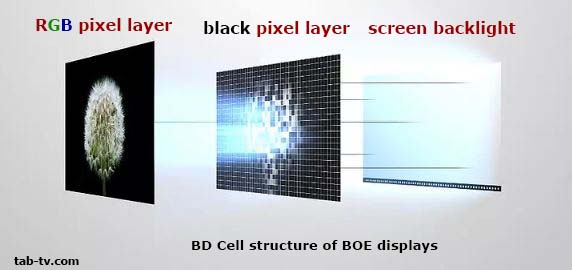In 2019, BOE introduced a revolutionary display technology with an impressive 150,000:1 contrast ratio. However, despite the promising potential, BD Cell displays remain absent from actual products and information about their applications remains limited. Four years later, the mystery surrounding these displays persists, prompting a closer look at their technology and challenges.
What is BD Cell display technology?
BD Cell displays are an advanced modification of IPS ADS technology with a characteristic two-layer structure:
- Backlight layer
- A layer of black and white pixels
- RGB matrix layer.
Essentially, this design combines two displays into one.
How do BD Cell displays work?
The innovative dual-layer structure allows the backlight to be controlled at the pixel level. Behind the first layer of black and white pixels is the backlight, this layer is like a high-precision filter that controls the backlight. The second layer, the RGB matrix, works like a normal display.
Traditional IPS displays do not cope well with the transmission of deep black color, because of the structure of the black color has a grayish tint even when displaying black images. By passing light through two layers of pixels, BD Cell displays allow for more subtle backlight control, reducing ghosting around bright objects and increasing contrast. The result is a bright, lifelike image with exceptional detail and realism.
Challenges and limitations
Despite their technical promise, BD Cell displays are not yet widely used in television production. This is probably due to the significant challenges associated with their manufacturing process. Creating two synchronized layers of controllable pixels requires precise engineering, especially when adjusting the black and white pixel layer to achieve optimal brightness and contrast. Even at minimum brightness, these pixels must transmit the right amount of light – a complex task that requires careful calibration.
Moreover, the advent of flexible OLED displays undermines many of BD Cell’s theoretical advantages. OLED technology offers near-perfect image quality at lower manufacturing costs and is already widely used for screens of various sizes.
While BD Cell displays remain an exciting innovation, their limited commercial presence suggests that technical and economic obstacles may prevent their widespread adoption. For now, OLED technology continues to dominate the market as a more affordable and cost-effective solution for premium displays.







